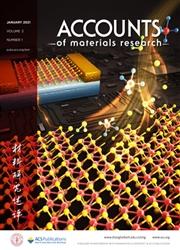Advancing Multiscale-Coupled Heterointerface Catalysts for Enhanced Water Electrolysis
IF 14.7
Q1 CHEMISTRY, MULTIDISCIPLINARY
引用次数: 0
Abstract
Green electricity powered water electrolysis stands out as a promising approach for hydrogen production, which is regarded as an ideal energy carrier due to its high energy density and clean combustion. However, its large-scale application is constrained by the high cost, stemming partially from the reliance on noble-metal-based catalysts to enhance the sluggish kinetics of hydrogen and oxygen evolution reactions. To address this challenge, multiscale-coupled heterointerface catalysts (MCHCs), which integrate single atoms, clusters, and nanoparticles into one independent system, have emerged as a potential alternative. They are composed of different active components at multiple scales to achieve strong synergistic effects, where single atoms provide highly active sites with unsaturated coordination environments, clusters enable tunable electronic properties to optimize intermediate binding, and nanoparticles contribute to conductive compensation and robust architecture. Through coupling engineering, these formed heterointerfaces can regulate electronic structures and geometric configurations to break the linear scaling relationship (LSR), simultaneously facilitating H2O activation and intermediate removal. Accordingly, such synergy enables the MCHCs to overcome thermodynamic and kinetic barriers in water electrolysis, significantly boosting the catalytic performance and durability.

用于强化水电解的多尺度耦合异质界面催化剂的进展
绿色电力水电解是一种很有前途的制氢方法,由于其高能量密度和清洁燃烧而被认为是理想的能量载体。然而,它的大规模应用受到高成本的限制,部分原因是依赖贵金属基催化剂来增强缓慢的析氢和析氧反应动力学。为了解决这一挑战,将单原子、团簇和纳米颗粒整合到一个独立系统中的多尺度耦合异质界面催化剂(MCHCs)作为一种潜在的替代方案出现了。它们由不同的活性成分在多个尺度上组成,以实现强大的协同效应,其中单原子提供具有不饱和配位环境的高活性位点,团簇实现可调的电子特性以优化中间结合,纳米颗粒有助于导电补偿和健壮的结构。通过耦合工程,这些形成的异质界面可以调节电子结构和几何构型,打破线性标度关系(LSR),同时促进H2O的活化和中间产物的去除。因此,这种协同作用使MCHCs克服了水电解过程中的热力学和动力学障碍,显著提高了催化性能和耐久性。
本文章由计算机程序翻译,如有差异,请以英文原文为准。
求助全文
约1分钟内获得全文
求助全文

 求助内容:
求助内容: 应助结果提醒方式:
应助结果提醒方式:


